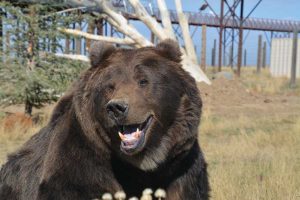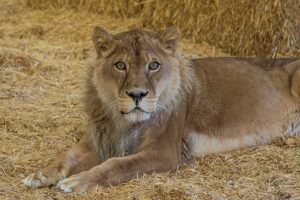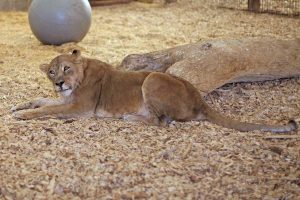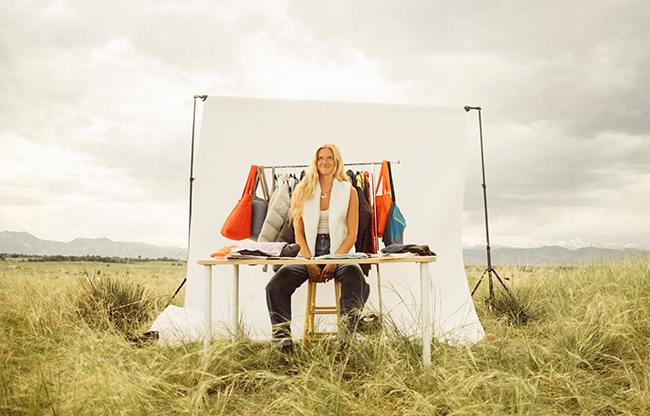Rescuing animals, helping them thrive at Wild Animal Sanctuary
01 Dec 2016
Tragic stories have happy endings at Wild Animal Sanctuary
By Ruthanne Johnson Their stories are enough to disgust any normal person. There’s George, a black bear blinded during his servitude as a laboratory research subject. And there are the two grizzlies who were being raised by a taxidermist to later be killed, stuffed and sold to the highest bidder because the man didn’t have enough taxidermy business.
Bears like Kody sometimes hadn’t been hibernating when they were rescued. Usually, they start again after they’ve been at the Wild Animal Sanctuary for a year. (Photo courtesy Wild Animal Sanctuary)
Then there are Leo, Leon, Zoya and Zinna—four lions who narrowly escaped being killed by authorities after their crazed owner, Terry Thomson, let loose his exotic animal menagerie in Zanesville, Ohio, before shooting himself on Oct. 18, 2011. Authorities killed 51 of his lions, tigers, cougars, bears, wolves and monkeys. The four lions survived only because they were being cared for on someone else’s property. These and hundreds of other animals with equally tragic stories all live at the Wild Animal Sanctuary in Keenesburg, Colo., just 50 miles east of Boulder off Highway 52. Sanctuary founder Pat Craig began rescuing exotic carnivores in the 1980s, caring for them first on his family’s Boulder farm, and now on 720 acres of open grassland. The animal enclosures range from 5 to 25 acres, housing animals such as lions, tigers, cougars, bears, bobcats and wolves. There’s even a raccoon and a camel, for some 430 animals in all. Kent Drotar, director of the Sanctuary Ambassador Program, began volunteering at the Wild Animal Sanctuary more than seven years ago, after learning about the rescue organization from his mom. “She had watched a show on ‘Animal Planet’ about Eddy the black leopard, who was hand raised by Pat,” remembers Drotar. Eddy was born at the sanctuary after his mother and several tigers and black leopards were rescued from another big-cat sanctuary that was in trouble. No one guessed that the female leopard was pregnant at the time of the rescue, and Eddy had to be taken out of the enclosure just after birth for his own safety. The show documented the first year of Eddy’s life with the Craig family, as well as his release into a large enclosure where he eventually lived out his life with animals of his own kind. Drotar was so impressed with the sanctuary that he began volunteering twice a week. Eventually, that turned into a position to help educate guests and the larger public about why there’s a need for such sanctuaries. He shares the animals’ stories with folks and talks about how staff cares for and helps the animals overcome often debilitating emotional and physical trauma. In the years since his first days as a volunteer, Drotar has seen it all: a lion from Mexico, who was being fed shelter pets; tigers and bears confiscated from private owners; animals surrendered from fur farms and hunting ranches; and animals rescued from horrendous living conditions in circuses and roadside zoos. Many, Drotar says, are coming from Central and South America, as a lot of those countries have recently passed bans on circus animals. But just as many of the sanctuary’s population come from living conditions that are downright dire right here in the United States, like two lionesses rescued in 2016 from Cricket Hollow Zoo in Manchester, Iowa. Authorities had been receiving complaints from visitors about the sick animals and filthy living conditions at the privately run roadside zoo. Even the business’s own Facebook photos showed the neglect. One visitor’s photo of an emaciated lioness sparked authorities to take action, and they called the Wild Animal Sanctuary for help. “She wasn’t even recognizable as a lion,” Drotar says. “She was that bad.”
After lions received their own federal protections in 2016, Njjarra and another lioness were able to be rescued from a roadside zoo in Iowa. (Photo courtesy Wild Animal Sanctuary)
Jonwah was rescued along with Njjarra from a roadside zoo in Iowa in 2016. She’s recovering from years of abuse—a long, slow process. (Photo courtesy Wild Animal Sanctuary)
Earlier that year, four tigers and three lemurs had been confiscated from the same roadside zoo because of the animals’ endangered status and transported to other sanctuaries. In 2016, lions finally received their own federal protections, enabling authorities to remove Jonwah and Njjarra. Sadly, the USDA renewed the zoo’s operating license, and dozens of other animals (who don’t enjoy federal protections) are still living there, including bears, wolves, birds, monkeys and a variety of farm animals and reptiles. Jonwah was so starved that she’d been eating whatever she could find in her enclosure, causing a life-threatening intestinal impaction. Veterinarians at Colorado State University in Fort Collins helped clear Jonwah’s intestines of a blockage of hay and grass. She’s on the mend, “but it’s going to be a long, slow process,” Drotar says. She also may have neurological issues caused by a previous head injury.
Mishmash of Laws
Part of the reason exotic animal sanctuaries are even needed is inconsistency and lack of laws across the country, says Craig. Since his first days rescuing, the laws have improved. “But the problem hasn’t gone away,” Drotar says. According to The Humane Society of the United States, only 21 states ban the ownership of dangerous exotic pets. The other states have a mishmash of laws, while five states have no laws regarding the ownership of dangerous exotic pets. “It’s estimated that there are about 25,000 large carnivore species of animals living outside of zoos in some sort of private ownership,” says Drotar. Another disturbing figure is the estimate of some 4,000 tigers being kept on Texas hunting ranches. Yet only 3,500 to 5,574 tigers remain in the wild. “When people hear that their jaws just drop because it’s so unbelievable,” Drotar says. A facility the size of the Wild Animal Sanctuary costs about $12 million a year to operate (think veterinarian services, ground maintenance, utilities and 40,000 pounds of food a week!). “About half of that comes from in-kind donations.” But it’s worth it. Especially when a visitor can see the animals begin to thrive and exhibit natural behaviors. Rescued bears, for example, don’t typically hibernate their first winter at the sanctuary. “They either don’t have enough fat stores or their body cycle is off,” Drotar says. Their second winter—after they’ve eaten their fill of fruits, vegetables, fish and raw meat—they cozy up for the winter in one of the concrete culverts the staff has mounded over with 6 feet of soil. The tigers get to swim in the sanctuary’s large pool and play with boomer balls spritzed with pumpkin-pie spice. The lions get to explore a Savannah grassland. The bobcats, servals and lynx get to climb atop natural vegetation and staff-built structures. The wolves get to lounge in dens and explore natural tree groves. But best of all, the animals get to live with their own kind. Though many arrive to the sanctuary socially damaged, staff works patiently to help them find friends they can live with. Like Chase, a tiger who came in angry at the world. He’d been taken from his mother a few days after birth and kept in a small cage for his first 7 years. “He hadn’t seen a tiger since and was scared to death of the two females in the enclosure next to him,” Drotar says. It took about three years of slow introductions through a fence, but Chase now lives in a large open habitat with those two young females. “It’s horrible what happens to these animals, but it’s a happy ending because they are here.”
For more information, visit the Wild Animal Sanctuary online.
Ruthanne Johnson is a former staff writer for The Humane Society of the United States. She loves dogs and pretty much every other animal on the planet, and advocates that they be treated humanely.















